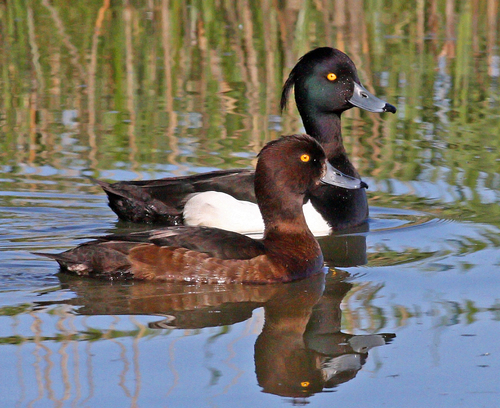
Tufted Duck
The Tufted Duck (Aythya fuligula) is a medium-sized diving duck found across Eurasia. It is easily recognizable by the male's distinctive tuft of feathers on the back of the head, contrasting with its black and white plumage. These ducks play an important role in freshwater ecosystems, helping to control populations of aquatic invertebrates and serving as prey for larger predators. While not generally considered culturally significant in the same way as some larger waterfowl, they are a familiar and appreciated sight in many urban and rural areas.
40-47 cm
Length
67-73 cm
Wingspan
Least Concern
Conservation Status
Distribution
The Tufted Duck has a broad distribution across Eurasia, breeding from Iceland and the British Isles in the west, through Scandinavia, Russia, and Siberia, to the Kamchatka Peninsula and Japan. They migrate south for the winter, reaching North Africa, the Middle East, the Indian subcontinent, and Southeast Asia. Altitudinal range varies, found from sea level to high-altitude lakes in some regions.
Lifespan
The average lifespan in the wild is around 4-5 years, but individuals can live up to 15 years or more.
Tufted Duck's Habitat
Habitat Types
Freshwater lakes, Reservoirs, Slow-moving rivers, Coastal lagoons, Marshes, Ponds
Climate Zones
Temperate, Boreal, Subarctic
Adaptations
Tufted Ducks are excellent divers, with legs positioned further back on their bodies to aid in underwater propulsion. They have a relatively high wing loading, requiring rapid wingbeats for flight, but allowing for efficient diving.
Variations
No widely recognized subspecies exist, although some minor regional variations in size and plumage darkness have been observed.
Appearance
Breeding Plumage
Breeding males have glossy black upperparts, head, and breast, with bright white flanks and a prominent tuft. Females are brown with paler flanks and a less distinct tuft. Non-breeding males (eclipse plumage) resemble females but retain some blacker tones.
Seasonal Feather Changes
Males undergo a complete molt after breeding, adopting the eclipse plumage. Females have less drastic seasonal changes.
Sex Based Plumage Differences
Strong sexual dimorphism is present, with males being much more strikingly colored than females.
Notable Features
Prominent head tuft (especially in males), Bright yellow eyes, Black bill with a greyish-blue band near the tip
Diet and Feeding
Primary Foods
Mollusks (especially mussels), Aquatic insects, Crustaceans, Seeds of aquatic plants, Small fish (occasionally)
Foraging Behavior
Tufted Ducks are diving ducks, typically foraging in water depths of 1-4 meters. They dive to the bottom and search for food by sight and touch, often upending to reach deeper items.
Specializations
Their bill shape and strong diving abilities are specializations for feeding on benthic invertebrates.
Seasonal Diet Variations
Diet can vary seasonally based on food availability. In winter, they may consume more plant material when invertebrates are less abundant.
Behavior
Social Structure
Tufted Ducks are generally gregarious, forming large flocks outside the breeding season. During breeding, they are more territorial, with pairs defending nesting areas.
Communication
Soft whistles and croaks by males during courtship, Quacking calls by females, especially when with young, Visual displays (head-bobbing, wing-flapping)
Migration
Many populations are migratory, undertaking long-distance movements between breeding and wintering grounds. Migration is often triggered by decreasing day length and temperature.
Territorial or Group Behaviors
During breeding, pairs defend a small territory around the nest site. Outside of breeding, they form large, mixed-species flocks with other diving ducks.
Conservation
Threats
Habitat loss and degradation (wetland drainage), Pollution (agricultural runoff, industrial discharge), Hunting (in some regions), Climate change (affecting breeding and wintering habitats), Disturbance from human activities (recreation)
Protection Programs
Wetland conservation and restoration initiatives, International agreements on migratory bird conservation (e.g., AEWA), Monitoring programs to track population trends
Local National Laws
Protected under various national wildlife protection laws in many countries within its range.
Population Trend
Stable
Population Estimates
The global population is estimated to be between 2.6 and 2.9 million individuals.
Interesting Facts
They can stay underwater for up to 25 seconds.
This allows them to reach food sources on the bottom of lakes and ponds.
The name 'Tufted Duck' refers to the male's crest.
This crest is a key feature used to identify the species, especially during the breeding season.
Hybridization with related species like pochards are rare but do occure.
These are rare events, but can cause difficulty in identification.
Faqs about Tufted Duck
Are Tufted Ducks endangered?
No, they are currently classified as 'Least Concern' by the IUCN, indicating a relatively stable global population.
What do Tufted Ducks eat?
They primarily feed on mollusks, aquatic insects, crustaceans, and plant seeds, which they obtain by diving.
Where do Tufted Ducks nest?
They nest on the ground, usually near water, in a shallow scrape concealed by vegetation.
Do both male and female care for the young?
No, the female is responsible for incubation and duckling care. The male will leave the female during incubation.
Copyright @ Nature Style Limited. All Rights Reserved.
 English
English